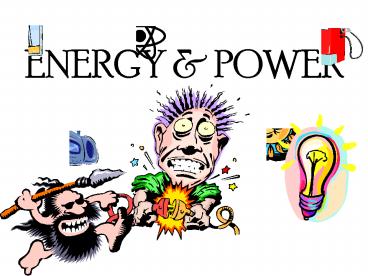ENERGY - PowerPoint PPT Presentation
1 / 17
Title:
ENERGY
Description:
Title: PowerPoint Presentation Last modified by: Eldred Central Schools Created Date: 1/1/1601 12:00:00 AM Document presentation format: On-screen Show (4:3) – PowerPoint PPT presentation
Number of Views:37
Avg rating:3.0/5.0
Title: ENERGY
1
ENERGY POWER
2
- Energy the ability to do work.
- Work and Energyare related, we give energy to an
object by doing work on the object. - Measuring Energy Because work is the transfer of
energy, we can measure energy by measuring the
work done.
3
- For example if a boat does 5,000 Newtons of
work, the engine of the boat put out 5,000 N-ms
of energy. - One Newton meter is to a Joule (J)
- So to find out how much energy is needed to do
something we use the formula for work.
4
- Kinetic Energy is the energy of motion.
- If you stop a moving object you can feel its
Kinetic Energy. - Kinetic Energy depends on two things.
- Mass Speed of the object.
More Kinetic Energy
100km/hr
100km/hr
5
- Calculating Kinetic Energy
- KE1/2mv2 answer is in Joules.
mass
velocity
- Example A girl has a mass of 40 kg skates around
a rink at 12m/s. What is her Kinetic energy?
6
- A boy has a mass of 120 kg runs at a speed of 4
m/s. What is his KE? - A man has a mass of 100 kg walks at a speed of 2
m/s. What is his KE?
7
3. A baseball with a mass of 0.08 kg is thrown at
a speed of 20 m/s. What is the KE of the
baseball? 4. A soccer ball with a mass of 2 kg
is kicked at a speed of 5 m/s. What is the KE of
the soccer ball?
8
- Potential Energy Is energy due to an objects
position. - Calculating Potential Energy Is work done or
Force X Distance Joules - Example If a boy carries a 70 n bowling ball up
a flight of 20 m high stairs. What is the balling
ball PE?
Answer 70 n X 20 m 1400 J
9
- Law of Conservation of Energy States that energy
cannot be created or destroyed. It can change
from one form to another. But the total amount of
energy remains the same. EXCEPT SOME IS LOST DUE
TO FRICTION
10
- Friction Wastes Energy
- The lower the friction the less energy wasted.
- The less energy wasted the faster you go.
- The less energy wasted the more PE converted to
KE.
PE
PE KE
PE if Stopped
11
- Forms of Energy
- Mechanical energy an object has from its motion.
- Internal energy from all the particles of an
object.
- Electrical electricity
12
- Chemical energy from an objects position and its
form of PE.
- Radiant energy in the form of a wave the sun
- Nuclear energy released from splitting or
combining atoms.
13
- Power is the rate at which work is done.
- Power work/time its the rate at which energy
is used. - Example If a person used 1200 Js of energy in
10 minutes how much power does that person have?
Answer 1200 J / 10 minutes 120 J/m Some times
we convert minutes to seconds for example 10
minutes 600 seconds.10 X 60.
- 1 Joule per second is equal to a watt (W)
- Power is measured in watts.
14
1- Chemical Energy Energy from an objects
position. (Potential Energy) 2- Electrical
Energy Energy that flows through a wire (Kinetic
Energy) 3- Energy The ability to do work. 4-
Internal Energy Energy to the particles that
make it up. 5- Joule Metric Unit for energy.
15
6- Kinetic Energy Energy because the object is
moving. 7- Law of Conservation of Energy Energy
cannot be created or destroyed. Energy changes
from on form to another. 8- Mechanical Energy
Energy an object has from its motion. 9- Nuclear
Energy Form of Potential energy the splitting of
atoms
16
10- Potential Energy Energy due to an objects
position. We give objects energy by doing work on
them. 11- Power The rate at which work is done.
12- Radiant Energy Energy from the sun in the
form of a wave. 13- Watt Metric unit for power.
17
14-If the rock's potential energy is100 J, the
hill is _________ high.
5 N
A
15-At point C, the rock's potential
energy will be __________ .
B
16-The rock's kinetic energy at point
A is __________.
C
17-At point B, some of the rock's potential
energy will be changed to. ___________________
_____________
18-The rock's potential energy at point A
is __________ than it's kinetic energy.

